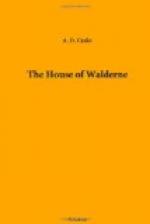Hubert followed the banner of Edward Longshanks both in Wales and Scotland ere he came home to his wife and children, satiated at last with war, and spent the rest of his days at Walderne. He died at a good old age, and was buried as a crusader in Lewes Priory, with crossed legs and half-drawn sword, where his tomb could be seen until the sacrilegious hands of the minions of Thomas Cromwell destroyed that noble edifice.
Mabel of Walderne retired, at her son’s persuasion, to a convent at Mayfield, where she ended her days in all the “odour of sanctity,” and Martin closed her eyes.
And lastly we have to tell of our Martin. He remained in the Andredsweald until he had completely succeeded in reconciling the outlaws to the authorities {37}, and he had seen them, his “merrie men,” settle down as peaceful tillers of the soil, or enter the service of the knights and abbots as gamekeepers, woodsmen, huntsmen, and the like; at his strong recommendation and assurance that he would be surety for their good behaviour—an assurance they did their best to justify.
And how shall we describe his labour of love—his work as the bondsman of Christ? But after the death of his mother, his superiors recalled him to Oxford, as a more important sphere, and better suited to his talents; where the peculiar sweetness of his disposition gave him a great influence over the younger students. In short he became a power in the university, and died head of the Franciscan house, loved and lamented, in full assurance of a glorious immortality. And they put over his tomb these words:
We know that we have passed from death to life, because we love the brethren. —Vale Beatissime.
From the south wall of Walderne Church project or projected two iron brackets with lances, whereon hung for many a generation the banners of Sir Ralph (alias Hubert) and his son Laurence.
The boast of chivalry, the pomp of power,
And all that beauty, all that wealth ere gave,
Await alike the inevitable hour,
The paths of glory lead but to the grave.
THE END.
Notes.
1
Rivingtons’
Historical Biographies.
2
Demonology
and Witchcraft.
3
See the
Andredsweald, a tale of the Norman Conquest, by the
same author.
4
He was the
last lord of Pevensey of his race, all his land
and honours
being forfeited in 1235 for passing over into
Normandy
without King Henry the Third’s license.
5
Lord of
Lewes Castle from 1242-1304, a local tyrant.
6
There were
then no family names, properly so called; the
English
generally took one descriptive of trade or
profession,
hence the multitude of Smiths; the Normans
generally
then name of their estate or birthplace, with the
affix De.
Knight’s Pictorial History, volume 2, page 643.




